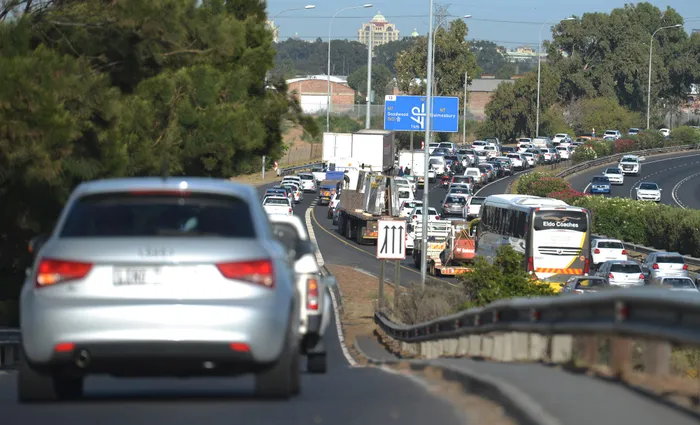EXPLAINED: Why an N1 inbound lane is closed and causing a traffic nightmare in Cape Town

The province’s Department of Infrastructure has had to close certain lanes of the N1 inbound near Sable Road as result of large pools of water on the roadway after two weeks of heavy rain. File picture: Independent Newspapers
Cape Town - The Western Cape government has given a detailed explanation why a lane on the N1 inbound near Sable Road has been closed, and why it is causing heavy congestion.
The province’s Department of Infrastructure closed certain lanes of the N1 inbound near Sable Road as result of large pools of water on the roadway after two weeks of heavy rain.
Engineering teams from the Western Cape government are on site to find alternative ways to supplement the stormwater drainage process.
In addition to normal maintenance work, teams will clear the earth drains along with specialised high-pressure cleaning of the pipe culverts.
The province said: “Our engineering teams have liaised with the City of Cape Town and other organs of state to attempt to tap into other existing systems to allow for the N1 stormwater drainage system to recover before the next major storm event.
“Unfortunately, the Western Cape government cannot predict how quickly the excess water will take to drain away so that all three lanes of the roadway can be reopened.”
The area is steadily drying out, and the roadway will be reopened when it is safe to do so.
The province said was aware that these lane closures were causing heavy congestion.
The wetland’s earth berm, adjacent to the N1, has been breached resulting in excess water flowing from the wetland onto the N1 road reserve.
“As a result of the wetland’s inability to hold and absorb the water, the roadway has flooded. This is due to the compounded impact of several days of rain over the current wet season.
“Over time, the soil will become less waterlogged, water will be absorbed into the ground, the flooding will abate, and it will be possible to reopen all three lanes of the N1 in this location.
“The stormwater drainage system is designed to ensure that water moves from one side of the N1 to the other via a number of pipe culverts or along open drainage systems to where it ultimately discharges near the Koeberg Interchange, some 2km away from the current flooded area,” the province said.
The stormwater drainage system on this part of the N1 was designed to only deal with road-related water run-off.
Any stormwater drainage system is designed to deal with a particular set of circumstances, but two weeks of heavy rain has pushed the system well beyond its capacity and it therefore cannot deal with the additional pressure and water from the wetland area.
The efforts to date:
There are three phases to the response from the Western Cape government.
Short-term/immediate:
Short-term/initial phase was to ensure road user safety with advance warnings, delineators, and the like.
Interim phase
Yesterday multiple parties tried to pump water from the area but as anticipated by the City’s specialist team of engineers, this did not yield any results.
The pumping continued well into the night and early hours of yesterday morning and included pumping to other sections of the drainage system which is why the Sable Road offramp was closed.
Water was pumped along the existing system to assist the system in recovering along its natural flow path towards the Koeberg interchange.
Pumping the water into tankers and transporting it offsite was also considered but based on conservative estimates, the submersible pumps would only yield an approximate capacity of 120m3/hour which would take more than three days to take the water away with a round-the-clock operation.
The use of sandbags to increase capacity of side drains was also tested but did not yield the required results and no additional lanes could be opened.
“Road users will note large equipment and plant over the past two days which are trying to create additional capacity in the system. This will continue along with regular high-pressure cleaning of drainage pipes and culverts to ensure no debris brought about by the flooding clogs the system.”
The department has also allocated additional resources from another contractor to assist with the efforts of the maintenance teams over the last week or so.
“We hope that this additional commitment will yield more favourable results. Currently the teams are working with Prasa, the City of Cape Town and the South African National Defence Force (Ysterplaat Air Force Base) to find additional points where water could be relayed to,” the province said.
Long-term phase
The long-term response would include creating additional capacity in the wetland but also increasing the capacity of the stormwater system along the N1.
Advocate Chantal Smith, Head of the Department of Infrastructure, said: “I can confirm that our team of engineers and teams on the ground are using all appropriate measures and techniques to address the problem as soon as possible.
“We wish to thank road users for their patience, we understand your frustrations. Thank you also to our teams who are working tirelessly and through the night to find solutions and to our partners for their support.”
Infrastructure MEC Tertuis Simmers said: “I want to assure the public that our department is fully committed to resolving this issue as swiftly and efficiently as possible. The safety of our road users is our top priority, and we are deploying all available resources to manage the situation.
“We understand the inconvenience this causes and appreciate your patience and cooperation as we work through these challenges. Together, with our dedicated teams and partners, we will restore normalcy to this critical route.”
Cape Argus
Related Topics: